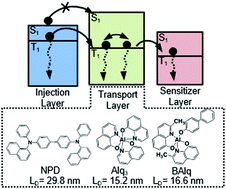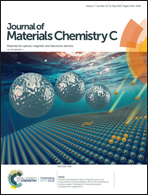Measurement of the triplet exciton diffusion length in organic semiconductors†
Abstract
We present a method to measure the exciton diffusion length (LD) of optically dark triplet excitons in organic semiconductor thin films. In order to directly probe only these states, triplets are optically injected into the material of interest via energy transfer from an adjacent phosphorescent thin film. Injected triplets migrate through the full thickness of the material before undergoing energy transfer to a phosphorescent sensitizer. By measuring photoluminescence from the sensitizer as a function of active layer thickness and sensitizer layer concentration, we are able to extract both LD and the transfer rate to the sensitizer. Extraction of the transfer rate is critical, as the assumption of unity quenching can lead to incorrect measurements of LD. We validate the method by measuring the singlet exciton diffusion length in the fluorophores tris-(8-hydroxyquinoline)aluminum (Alq3) and 2,3,6,7-tetrahydro-1,1,7,7,-tetramethyl-1H,5H,11H-10(2-benzothiazolyl)quinolizine-[9,9a,1gh] coumarin (C545T), and comparing them with values extracted from conventional photoluminescence quenching measurements. The triplet LD is subsequently extracted for a series of archetypical fluorescent organic semiconductors with values falling in the range of 15–30 nm. In addition to probing the diffusion of dark triplets, this method also offers the ability to measure the singlet and triplet LD with only a change in injection layer.

- This article is part of the themed collection: Editor’s Choice: Progress in singlet fission and photon upconversion


 Please wait while we load your content...
Please wait while we load your content...
